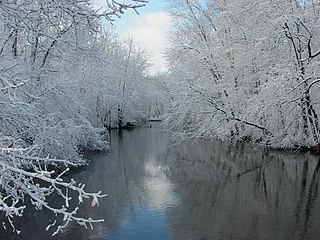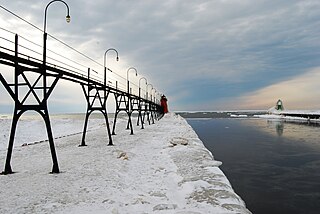| Rocky River | |
|---|---|
The Rocky River in Flowerfield Township | |
| Country | United States |
| Physical characteristics | |
| Main source | Southwest Marcellus Township in Cass County, Michigan |
| River mouth | St. Joseph River in Three Rivers |
| Length | 28 mi (45 km) [1] |
| Discharge |
|
| Basin features | |
| River system | St. Joseph River |
| Basin size | 450 km2 (170 sq mi) [2] |
The Rocky River is a 28.3-mile-long (45.5 km) [1] stream located in the southwest part of the U.S. state of Michigan that flows into the St. Joseph River at 41°56′33″N85°37′59″W / 41.94250°N 85.63306°W [3] in the city of Three Rivers in St. Joseph County. The Rocky River, along with the St. Joseph River and the Portage River, are the three rivers from which the city of Three Rivers takes its name.
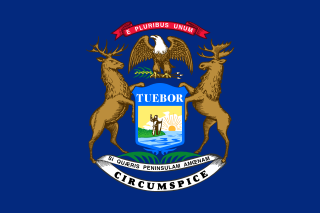
Michigan is a state in the Great Lakes and Midwestern regions of the United States. The state's name, Michigan, originates from the Ojibwe word mishigamaa, meaning "large water" or "large lake". With a population of about 10 million, Michigan is the tenth most populous of the 50 United States, with the 11th most extensive total area, and is the largest state by total area east of the Mississippi River. Its capital is Lansing, and its largest city is Detroit. Metro Detroit is among the nation's most populous and largest metropolitan economies.
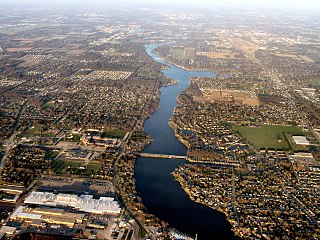
The St. Joseph River is a 206 miles (332 km) long tributary of Lake Michigan flowing generally westerly through southern Michigan and northern Indiana, United States, to its terminus on the southeast shore of the lake. It drains a primarily rural farming area in the watershed of Lake Michigan. It was enormously important to Native Americans and greatly aided in the colonial exploration, settlement and administration of New France and the nascent United States as a canoe route between Lake Michigan and the watershed of the Mississippi River.
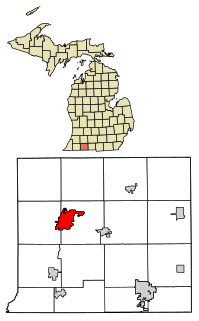
Three Rivers is a city in St. Joseph County in southwestern Michigan in the United States. The population was 7,811 at the 2010 census.
The Rocky River rises in southwest Marcellus Township in Cass County at 41°59′43″N85°51′04″W / 41.99528°N 85.85111°W . [3] It flows to the northeast, arcing gently to the southeast before turning sharply to the south in eastern Flowerfield Township, shortly after being joined by the Flowerfield Creek. It then flows mostly southward until joining the St. Joseph River in Three Rivers.

Marcellus Township is a civil township of Cass County in the U.S. state of Michigan. The population was 2,539 at the 2010 census. The village of Marcellus is within the township.

Cass County is a county in the U.S. state of Michigan. As of the 2010 census, the population was 52,293. Its county seat is Cassopolis.

Flowerfield Township is a civil township of St. Joseph County in the U.S. state of Michigan. The population was 1,592 at the 2000 census.
The Rocky River watershed encompasses over 112,000 acres (45,000 ha) and drains all or portions of the following cities and townships: [2]
- In Cass County
- In Kalamazoo County
- Prairie Ronde Township (via Flowerfield Creek)
- Schoolcraft Township (via Spring Creek)
- Texas Charter Township

Prairie Ronde Township is a civil township located in the extreme southwestern corner of Kalamazoo County in the U.S. state of Michigan. The population was 2,086 at the 2000 census.

Schoolcraft Township is a civil township of Kalamazoo County in the U.S. state of Michigan. The population was 7,260 at the 2000 census. The township is named for Henry Schoolcraft, noted for conducting many early land surveys throughout Michigan.

Texas Charter Township, officially named the Charter Township of Texas, is a charter township of Kalamazoo County, in the U.S. state of Michigan. As of the 2000 census, the township population was 10,919. It encompasses the entire portion of the survey township T3S R12W.
- In St. Joseph County
- Fabius Township (via Kerr Creek)
- Flowerfield Township
- Lockport Township
- Park Township
- Three Rivers
- In Van Buren County
- Porter Township (via Sheldon Creek, Flowerfield Creek, and Four County Drain)

Newberg Township is a civil township of Cass County in the U.S. state of Michigan. The population was 1,632 at the 2010 census.

Penn Township is a civil township of Cass County in the U.S. state of Michigan. The population was 1,774 at the 2010 census.

Volinia Township is a civil township of Cass County in the U.S. state of Michigan. The population was 1,112 at the 2010 census. When the township was organized in 1833, it was at first named Volhynia, after the province in Poland. It is believed to have been given to honor General Tadeusz Kościuszko, the Polish patriot who helped the United States during the American Revolutionary War. The name was altered first to "Volenia" and then by 1901 or earlier to "Volinia".

